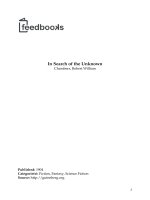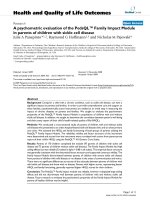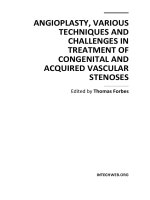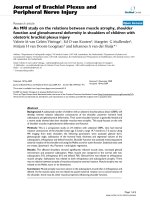vietnam poison control center challenges in poisonings of children
Bạn đang xem bản rút gọn của tài liệu. Xem và tải ngay bản đầy đủ của tài liệu tại đây (1.35 MB, 22 trang )
1
Vietnam Poison Control Center
Challenges in poisonings of children
Prof. Nguyen Thi Du, MD, PhD
Director, Vietnam Poison Control Center
Bach Mai University Hospital
Head, Dept. of Emergency, Intensive
Care Medicine and Toxicology
Hanoi Medical University
Pham Due, MD, PhD
Vice Director, Vietnam PCC
Email:
2
Introduction
Toxicologic epidemiology: General condition
Poison control centre
Organization and functions
Intoxication report
Poisoning in Children at Vietnam PCC
3
Vietnam in brief
A developing country 330 900Km
2
Population > 80 million
Vietnam is an agricultural country, farmers: 80%
Explosion of economic from 1986, but imbalance in social
development and state management
Health care system based on 64 provincial hospitals, 500
district medical stations, but only PCC placed in Ha Noi (Bach
Mai university hospital), other poisoning patients admitted to
EM & ICU at local hospitals.
4
Toxicological epidemiology
general condition
Economic explosion developed increasing risks from using toxic
chemicals in agriculture and industry
Tropics: venomous animals, poisonous plants
1996 1997 1998 1999 2000
Poisoning patients 9524 10372 8110 8339 8916
Poison-related deaths 273 335 305 252 244
% Mortality 2.86% 3.23% 3.76% 3.02% 2.74%
Reported from 48 local hospitals in 2000, Vietnam MoH
5
Toxicological
epidemiology
general condition
24.81%
17.76%
17.67%
12.16%
8.12%
4.77%
2.64%
1.47%
10.60%
0.00%
5.00%
10.00%
15.00%
20.00%
25.00%
Pesticides Sedative-
drugs
Food
poisoning
Rodenticides Venemous
animal
Opiates alcohol Chemical Other
reasons
First range: pesticides (rodenticide-
trifluoroacetamide, OPs, new insecticides-
nereistoxin , herbicide)
Second: sedatives and drugs abuse or overdose,
opiates and alcohol
Third: venomous animals and plants:
snakebite, puffer fish, bee stings, toad venom,
poisonous plants, mushroom
6
Toxicologic
Epidemiology
reported
cases. (% of
total)
Numeral mortality
(Mortality,
expressed in % of
reported)
1. Pesticides
24.81% 6.61%
2. Sedative-drugs
17.76% 0.86%
3. Food poisonings
17.67% 0.24%
4. Rodenticides
12.16% 3.5%
5. Venomous animal
8.12% 3.42%
6. Opiates
4.77%
5.12%
7. Alcohol
2.64% 0.28%
8. Chemicals
1.47% 6.17%
9. Other causes
10.6% 7.48%
Total
100% 3.26%
Survey in 48
local hospitals
7
Vietnam Poison Control Center
Vietnam Poison Control Center (PCC)
established in 1998, was the first Clinical
Toxicology Center in Vietnam.
PCC: organized with 4 units: Clinical Toxicology
Unit, Toxicology Lab, Information Unit, Venom
Research & Antivenom Unit.
PCC personnel: Head: Prof. Nguyen Thi Du,
7 doctors, 22 nurses, 1 pharmacists, 1 bachelor of
Chemistry and 1 IT engineer.
8
Poison Control Center
Treatment for >1500
poisoning patients per year
Training for under and
postgraduate students
Laboratory support
Establish toxicology
database, case report system, treatment
protocols.
Consult for doctors in
other hospital
Some TV programs for antipoison
knowledges.
main activities
L i b r a r y d a t a b a s e s , H a n d b o o k s , R e c o r d s .
I n t e r n e t w e b - s i t e s o t h e r p o i s o n i n f o . c e n t e r s
M e d l i n e ,
V i e t n a m e s e P o i s o n i n g C a s e D a t a b a s e
I n t e r n a t i o n a l r e s e a r c h c o l l a b o r a t i o n
U n d e r - a n d p o s t - g r a d u a t e e d u c a t i o n
M a s s m e d i a p u b l i c i n f o r m a t i o n
P o i s o n R e s e a r c h a n d
I n f o r m a t i o n C e n t e r
L a b o r a t o r y s e r v i c e s
C h e m i c a l i d e n t i f i c a t i o n b l o o d , u r i n e , s a m p l e s
C l i n i c a l c h e m i s t r y a n a l y s i s o f t o x i c e f f e c t s
6 1 P r o v i n c i a l h o s p i t a l s
E m e r g e n c y c a r e d e p a r t m e n t s
C l i n i c a l u n i t
2 0 i n t e n s i v e c a r e b e d s a t B a c h M a i h o s p i t a l
B e d s a t e m e r g e n c y w a r d s , c o l l a b o r a t i n g h o s p i t a l s
N a t i o n a l P o i s o n C o n t r o l C e n t r e
o f V i e t N a m
L o c a t e d a t B a c h M a i H o s p i t a l
H a N o i , V i e t N a m
9
Poison Control Center
treated patients in the first 5 years
Year 1998 1999 2000 2001 2002 2003
P
oisoning patients 118 526 740 1100 1817 1669
Deaths of poisoning 10 6 10 15 18 14
Mortality (%) 8.5 1.14 1.35 1.36 0.99 0.84
10
Poison Control Center
epidemic study in the year 2003
Humicide Misuse Suicide Accidental Total
5
0.3%
9
0.5%
395
23.7%
1260
75.5%
1669
Reasons of poisoning
11
Poison control center
epidemic study in the year 2003
Causes Total
Food poisoning 567
Sedative/hypnotics 305
Evenomation 227
Substance of abuse 205
Pesticide 149
Houshold products 47
Plant 31
Heavy metals 9
Accidental 8
Causes of
poisoning
12
Poison control center
toxicological lab work in 2003
-
Tox. tests for pts treated in PCC: 4198
-
Tox. tests for pts in other hospitals: 199
-Sending samples to other Labs: 305
-Co-operation in toxicological analysis with experts in Pharmacology
School and botanists
Results of toxicologic analysis
Medications Pesticides Drugs
of abuse
Alkaloide Household
products
Total
2456 625 877 234 6 4198
58.5% 14.9% 20.9% 5.6% 0.1%
13
Poison control center
some recent publications
-
Use PSS to classify the acute poisoning patients, Nguyen Thi Minh Tam, Nguyen Thi Du
-
Study of correlation between serum-cholinesterase and clinical signs in
organophosphate poisoning, Pham Due, Nguyen Thi Du
-
Use atropin and hight dose of PAM in organophosphat poisoning, Pham Due, Nguyen
Thi Du
-
Nereistoxin poisoning, Nguyen Thi Du, Pham Due
-
Lead and mercury poisoning from traditional medicine, Pham Due, Nguyen Thi Du
-
Thallium poisoning – case series, Nguyen Thi Du
-
Treatment of Naja Kaothia envenomations using monospecific antivenom, Nguyen Kim
Son, Vu Van Dinh
-
Buffotoxin poisoning, Pham Due, Nguyen Thi Du
-
Acute renal failure in acute poisoning of fish bile, Pham Due, Nguyen Thi Du
-
Acute poisoning in children in Pediastric Hospital I and II in 2002, Nguyen Thi Du, Vu
Dinh Thang
14
Children's vulnerability
More children died in drownings than from plague, cholera, typhoid and malaria
combined
More children die of poisonings in the home than Japanese B encephalitis (The US
Ambassador-Pete Peterson-2000)
Over 7% admitted poisoning patients are children.
Most are accidental poisonings
Mass poisonings in school caused by remain warfare in the South and
BuonMathuot province (CS)
fall
2%
drowning
29%
traffic acci.
8%
unknown
8%
electric shock
2%
other injuries
45%
poisoning
6%
Chart of
dead
children,
survey of
US
Embassy
-2000
15
Poison Control Center
Children Poisoning in 2003
Male Female
Age (year) 0 - 4 5 - 14 15 - 19 0 - 4 5 - 14 15 -19
Poisoning pts 4 47 84 3 27 108
Suicide 0 4 25 0 5 61
Misuse 1 1 0 0 0 0
Homicide 0 0 1 0 0 0
Accident 3 42 53 3 22 47
* Report of Vietnam Poison Control Center
16
0
20
40
60
80
Pts number
Poison Control Center
Children Poisoning in 2003
Causes of poisoning
17
Poison Control Center
Poisoning in children
18
Poison Control Center
Poisoning in children
Theses:
2002: Acute poisoning in children at the
National Hospital of Pediastrics of Vietnam in 4
years
Long Nary
2003: Acute poisoning in children in 2 National
Hospital of Pediastrics of Ho Chi Minh city in
2002
Nguyen Thi Du, Vu Dinh Thang
19
Poison Control Center
Poisoning in children
Some important findings:
male > female
main reason: accidental (479/517 cases, 92.6%)
common poisons: pesticides, snakebites, bee stings,
medications (hypnotics, cough and cold )
causes of death: North: rodenticides
South: paraquat, snakebite
20
Poison Control Center
Poisoning in children
Problems and challenges:
Lack of knowledge and information for effectively preventive
policy and measures
Lack of programs for educating public, children in schools
No hot line for couselling people in community, medical
staffs in hospitals
No National network for intoxication information, especially
for building intoxication database
Lack of antidotes and effective treatment protocols,
qualification toxicologists
21
Poison Control Center
Poisoning in children
What should we do ?
Investigation, in-depth researchs focusing on preventable
reasons of poisonings in children
Create educational programs on intoxication for mass media,
comunication activities, in schools
Set up website, hotline for couselling
Establish the national network of PCCs and network system
for poisoning information
Clinical researchs to improve diagnosis and treatment
capacity for children poisonings
Thank you for your attention
Thank you for your attention









